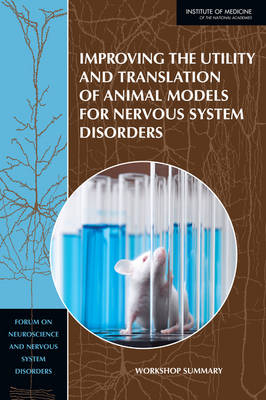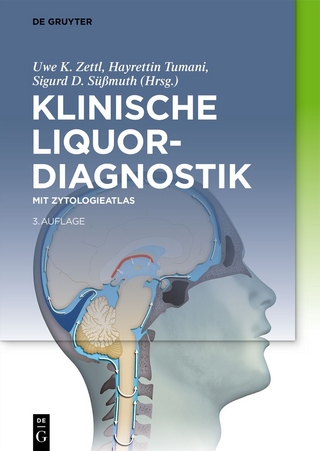
Improving the Utility and Translation of Animal Models for Nervous System Disorders
Workshop Summary
Seiten
2013
National Academies Press (Verlag)
978-0-309-26633-8 (ISBN)
National Academies Press (Verlag)
978-0-309-26633-8 (ISBN)
Identifies methods to facilitate development of corresponding animal and clinical endpoints, indentifies methods that would maximize bidirectional translation between basic and clinical research and determines the next steps that can be critical for improvement of the development and testing of animal models of disorders of the nervous system.
Nervous system diseases and disorders are highly prevalent and substantially contribute to the overall disease burden. Despite significant information provided by the use of animal models in the understanding of the biology of nervous system disorders and the development of therapeutics; limitations have also been identified. Treatment options that are high in efficacy and low in side effects are still lacking for many diseases and, in some cases are nonexistent. A particular problem in drug development is the high rate of attrition in Phase II and III clinical trials. Why do many therapeutics show promise in preclinical animal models but then fail to elicit predicted effects when tested in humans?
On March 28 and 29, 2012, the Institute of Medicine Forum on Neuroscience and Nervous System Disorders convened the workshop "Improving Translation of Animal Models for Nervous System Disorders" to discuss potential opportunities for maximizing the translation of new therapies from animal models to clinical practice. The primary focus of the workshop was to examine mechanisms for increasing the efficiency of translational neuroscience research through discussions about how and when to use animal models most effectively and then best approaches for the interpretation of the data collected. Specifically, the workshop objectives were to: discuss key issues that contribute to poor translation of animal models in nervous system disorders, examine case studies that highlight successes and failures in the development and application of animal models, consider strategies to increase the scientific rigor of preclinical efficacy testing, explore the benefits and challenges to developing standardized animal and behavioral models. Improving the Utility and Translation of Animal Models for Nervous System Disorders: Workshop Summary also identifies methods to facilitate development of corresponding animal and clinical endpoints, indentifies methods that would maximize bidirectional translation between basic and clinical research and determines the next steps that will be critical for improvement of the development and testing of animal models of disorders of the nervous system.
Table of Contents
Front Matter
1 Introduction and Overview
2 Evaluation of Current Animal Models
3 Translation from Animal Models to the Clinic: Case Examples from Neuroscience Research
4 Perspectives on Standardization
5 Perspectives on Corresponding Animal and Clinical Endpoints
6 Addressing the Translational Disconnect
7 Summary of Workshop Topics
Appendix A: References
Appendix B: Workshop Agenda
Appendix C: Registered Attendees
Nervous system diseases and disorders are highly prevalent and substantially contribute to the overall disease burden. Despite significant information provided by the use of animal models in the understanding of the biology of nervous system disorders and the development of therapeutics; limitations have also been identified. Treatment options that are high in efficacy and low in side effects are still lacking for many diseases and, in some cases are nonexistent. A particular problem in drug development is the high rate of attrition in Phase II and III clinical trials. Why do many therapeutics show promise in preclinical animal models but then fail to elicit predicted effects when tested in humans?
On March 28 and 29, 2012, the Institute of Medicine Forum on Neuroscience and Nervous System Disorders convened the workshop "Improving Translation of Animal Models for Nervous System Disorders" to discuss potential opportunities for maximizing the translation of new therapies from animal models to clinical practice. The primary focus of the workshop was to examine mechanisms for increasing the efficiency of translational neuroscience research through discussions about how and when to use animal models most effectively and then best approaches for the interpretation of the data collected. Specifically, the workshop objectives were to: discuss key issues that contribute to poor translation of animal models in nervous system disorders, examine case studies that highlight successes and failures in the development and application of animal models, consider strategies to increase the scientific rigor of preclinical efficacy testing, explore the benefits and challenges to developing standardized animal and behavioral models. Improving the Utility and Translation of Animal Models for Nervous System Disorders: Workshop Summary also identifies methods to facilitate development of corresponding animal and clinical endpoints, indentifies methods that would maximize bidirectional translation between basic and clinical research and determines the next steps that will be critical for improvement of the development and testing of animal models of disorders of the nervous system.
Table of Contents
Front Matter
1 Introduction and Overview
2 Evaluation of Current Animal Models
3 Translation from Animal Models to the Clinic: Case Examples from Neuroscience Research
4 Perspectives on Standardization
5 Perspectives on Corresponding Animal and Clinical Endpoints
6 Addressing the Translational Disconnect
7 Summary of Workshop Topics
Appendix A: References
Appendix B: Workshop Agenda
Appendix C: Registered Attendees
1 Front Matter; 2 1 Introduction and Overview; 3 2 Evaluation of Current Animal Models; 4 3 Translation from Animal Models to the Clinic: Case Examples from Neuroscience Research; 5 4 Perspectives on Standardization; 6 5 Perspectives on Corresponding Animal and Clinical Endpoints; 7 6 Addressing the Translational Disconnect; 8 7 Summary of Workshop Topics; 9 Appendix A: References; 10 Appendix B: Workshop Agenda; 11 Appendix C: Registered Attendees
| Verlagsort | Washington |
|---|---|
| Sprache | englisch |
| Maße | 152 x 229 mm |
| Themenwelt | Medizin / Pharmazie ► Medizinische Fachgebiete ► Laboratoriumsmedizin |
| Medizin / Pharmazie ► Medizinische Fachgebiete ► Neurologie | |
| ISBN-10 | 0-309-26633-5 / 0309266335 |
| ISBN-13 | 978-0-309-26633-8 / 9780309266338 |
| Zustand | Neuware |
| Haben Sie eine Frage zum Produkt? |
Mehr entdecken
aus dem Bereich
aus dem Bereich
Buch | Softcover (2021)
Deutscher Ärzteverlag
CHF 41,95
mit Zytologieatlas
Buch | Hardcover (2025)
De Gruyter (Verlag)
CHF 244,90
ein praxisorientiertes Handbuch
Buch | Hardcover (2023)
Wiley-VCH Verlag GmbH
CHF 69,85


